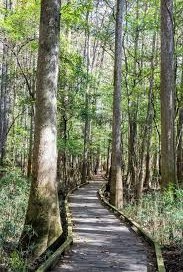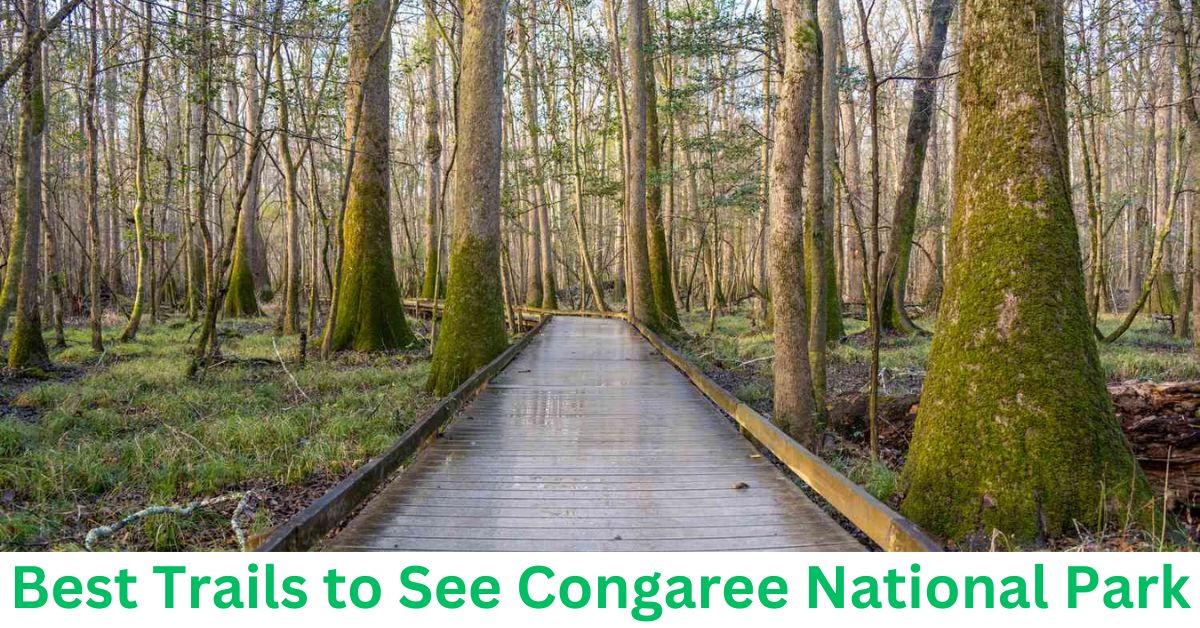Top Trails for Exploring Congaree National Park Wonders
One of the best ways to experience the stunning sights of Congaree National Park is through a day hike. Four key trails provide access to the park’s most breathtaking features, including ancient old-growth forests, the tallest loblolly pine, rare bird species, and diverse swamp wildlife.
Discovering Old-Growth Forests in Congaree National Park
Congaree National Park preserves the largest expanse of old-growth bottomland hardwood forest in the United States. This remarkable ecosystem is home to six national- and 23 state-champion trees. Visitors can admire these towering giants along the 2.4-mile Boardwalk Loop, which meanders beneath the lush canopy of ancient bald cypress and water tupelo trees in what is often referred to as “Redwood East.”
The Boardwalk Loop offers an easy, accessible hike that serves as an excellent introduction to the park’s unique ecosystem. As visitors traverse this scenic trail, they can observe towering cypress knees emerging from the swampy terrain, creating a landscape reminiscent of a prehistoric era. The tranquil surroundings provide a serene escape into nature, making this one of the most beloved trails in Congaree National Park.
How Long is the Boardwalk Trail at Congaree National Park?
The Boardwalk Trail at Congaree National Park is approximately 2.4 miles long. This trail is well-maintained and accessible, making it suitable for hikers of all skill levels, including families with children and those who prefer an easy yet immersive nature walk.
World’s Tallest Loblolly Pine in Congaree National Park
The park boasts the tallest (169 feet or about 17 stories) and largest (42 cubic meters) loblolly pine alive today. That pine can be seen just off the Weston Lake Loop Trail, which runs 4.6 miles roundtrip from the visitor center.
Hikers on the Weston Lake Loop Trail will traverse a diverse landscape that showcases Congaree National Park’s unique blend of wetland and forested habitats. This trail offers a prime opportunity to appreciate the awe-inspiring height of the world’s tallest loblolly pine, a must-see attraction for nature enthusiasts and photographers.
What is So Special About Congaree National Park?
Congaree National Park is special because it preserves one of the last remaining old-growth floodplain forests in North America. The park’s biodiversity, unique wetland ecosystem, and towering champion trees make it a truly one-of-a-kind destination for hikers, birdwatchers, and wildlife enthusiasts.
Rare Birds in Congaree National Park
Designated an internationally Globally Important Bird Area, Congaree National Park is home to such rare birds as the prothonotary warbler and the swallow-tailed kite and offers one of the nation’s most diverse (eight species) and densest concentrations of woodpeckers. A number of these birds can be spotted by taking a short segment of the 11.1-mile King Snake Trail.
For birdwatchers, King Snake Trail is a must-visit. The trail’s remote location ensures a quiet and undisturbed environment, making it an excellent place for spotting rare and migratory birds. Early mornings and late afternoons are the best times to see these magnificent creatures in their natural habitat.
Are There Bears in Congaree National Park?
While Congaree National Park is home to diverse wildlife, black bears are not commonly sighted in the park. However, visitors should always remain cautious and follow park guidelines when exploring its vast wilderness.
Swamp Wildlife in Congaree National Park
A variety of animals – including alligators, armadillos, bobcats, coyotes, deer, feral pigs, river otters, snakes, turkeys, and turtles – can be found in Congaree National Park. The safer mammal species usually can be spotted on the 0.7-mile Bluff Trail, which crosses a small rise at a floodplain’s edge.
Wildlife enthusiasts will enjoy the Bluff Trail’s diverse animal sightings. This short but rewarding hike offers a chance to observe Congaree’s swamp-loving creatures in their natural habitat, making it an ideal trail for those interested in the park’s fauna.

Are There Alligators in Congaree National Park?
Yes, alligators can be found in Congaree National Park, particularly in the park’s waterways and swamps. While sightings are not as frequent as in other southern wetlands, visitors should always exercise caution and maintain a safe distance when near water.
Is Congaree National Park Worth Visiting?
Absolutely! Congaree National Park offers a unique experience for nature lovers, hikers, and photographers. From its towering old-growth trees to its rich biodiversity, the park provides an unparalleled opportunity to explore a preserved wetland ecosystem.
Is Congaree National Park Dog-Friendly?
Yes, Congaree National Park is dog-friendly! Visitors can bring their furry friends along the park’s trails, provided they are kept on a leash at all times. This makes it a great destination for pet owners who enjoy hiking with their dogs.
How Much Time Do You Need at Congaree National Park?
A visit to Congaree National Park can range from a few hours to a full day, depending on your interests. If you plan to explore multiple trails and take in the park’s highlights, setting aside at least 4-6 hours is recommended. However, shorter visits focused on the Boardwalk Loop can be equally rewarding.
What is the Best Time of Year to Visit Congaree National Park?
The best time to visit Congaree National Park is during the fall and spring seasons when temperatures are mild, and mosquito activity is lower. These seasons provide optimal conditions for hiking, birdwatching, and wildlife spotting.
Conclusion
Exploring Congaree National Park’s best trails allows visitors to experience the park’s incredible biodiversity, towering trees, and unique swamp ecosystem. Whether you’re hiking the Boardwalk Loop to witness old-growth forests, trekking the Weston Lake Loop to see the tallest loblolly pine, birdwatching along King Snake Trail, or spotting wildlife on the Bluff Trail, Congaree National Park promises an unforgettable adventure for all nature lovers. If this Blog Post Helps you share with your friends follow us for more hiking Guide and Tips also on social media to get updates Thank you for visiting – myhikingguide.com

